Research on the Spatial Structure of the European Union’s Tourism Economy and Its Effects
Abstract
:1. Introduction
2. Literature Review
2.1. Research on Spatial Structure Studies of European Tourism
2.2. Research on the Network Structure of Scenic Spots in Tourism Destination
2.3. Research on Network Structure among Tourism Destinations Based on Counties and Provinces
2.4. Research on Network Structure among Tourism Destinations Based on Countries and Regions
3. Methodology
3.1. The Modified Tourism Gravity Model
3.2. Social Network Analysis
3.2.1. Complete Network Characteristic Index
3.2.2. Ego Network Characteristic Index
3.2.3. Core-Periphery Model
3.3. Study Area
3.4. Data Source
4. Spatial Structure Characteristics of the EU Tourism Economy
4.1. Analysis of Tourism Economic Connection Strength
4.2. Characteristics of Complete Network
4.2.1. Construction of Cyberspace Structure
4.2.2. Network Density
4.2.3. Network Relevance
4.3. Characteristics of the Ego Network
4.3.1. Degree Centrality
4.3.2. Betweenness Centrality
4.3.3. Closeness Centrality
4.4. Core Periphery Analysis
4.5. EU Accession Will Effectively Enhance Degree Centrality
5. Analysis of the Spatial Network Effect of the EU Tourism Economy
5.1. Effect Analysis of the Complete Network Structure
5.1.1. Effect of the Complete Network Structure on Tourism Industry Specialization
5.1.2. Effect of the Complete Network Structure on the Tourism Economic Development Level
5.2. Effect Analysis of the Ego Network Structure
6. Conclusions and Implications
6.1. Conclusions
6.2. Implications
Author Contributions
Funding
Institutional Review Board Statement
Informed Consent Statement
Data Availability Statement
Conflicts of Interest
References
- Nicolescu, L.; Maria-Irina, A. The Effects of European Integration in the Tourism Industry: Consequences of the Last Accession Waves. In Doing Business in Europe; Springer: Cham, Switzerland, 2018; pp. 271–293. [Google Scholar]
- Halkier, H. EU and Tourism Development: Bark or Bite? Scand. J. Hosp. Tour. 2010, 10, 92–106. [Google Scholar] [CrossRef]
- Jarvis, J.; Kallas, P. Estonian Tourism and the Accession Effect: The Impact of European Union Membership on the Contemporary Development Patterns of the Estonian Tourism Industry. Tour. Geogr. 2008, 10, 474–494. [Google Scholar] [CrossRef]
- Hall, D. From ‘Bricklaying’ to ‘Bricolage’: Transition and Tourism Development in Central and Eastern Europe. Tour. Geogr. 2008, 10, 410–428. [Google Scholar] [CrossRef]
- Valls, J.-F.; Sureda, J.; Valls-Tuñon, G. Attractiveness Analysis of European Tourist Cities. J. Travel Tour. Mark. 2014, 31, 178–194. [Google Scholar] [CrossRef]
- Frantz, M.D. Tourism marketing and urban politics: Cultural planning in a European capital. Tour. Geogr. 2018, 20, 481–503. [Google Scholar] [CrossRef]
- Wall-Reinius, S.; Ioannides, D.; Zampoukos, K. Does geography matter in all-inclusive resort tourism? Marketing approaches of Scandinavian tour operators. Tour. Geogr. 2019, 21, 766–784. [Google Scholar] [CrossRef]
- Amelung, B.; Viner, D. Mediterranean Tourism: Exploring the Future with the Tourism Climatic Index. J. Sustain. Tour. 2006, 14, 349–366. [Google Scholar] [CrossRef]
- Rátz, T.; Smith, M.; Michalkó, G. New Places in Old Spaces: Mapping Tourism and Regeneration in Budapest. Tour. Geogr. 2008, 10, 429–451. [Google Scholar] [CrossRef]
- Matoga, Ł.; Pawłowska, A. Off-the-beaten-track tourism: A new trend in the tourism development in historical European cities. A case study of the city of Krakow, Poland. Curr. Issues Tour. 2018, 21, 1644–1669. [Google Scholar] [CrossRef]
- Shoval, N. Urban planning and tourism in European cities. Tour. Geogr. 2018, 20, 371–376. [Google Scholar] [CrossRef]
- Mansilla, J.A.; Milano, C. Becoming centre: Tourism placemaking and space production in two neighborhoods in Barcelona. Tour. Geogr. 2019. [Google Scholar] [CrossRef]
- Bohlin, M.; Brandt, D.; Elbe, J. Spatial Concentration of Tourism—A Case of Urban Supremacy. Tour. Plan. Dev. 2020. [Google Scholar] [CrossRef]
- González-Pérez, J.M. The dispute over tourist cities. Tourism gentrification in the historic Centre of Palma (Majorca, Spain). Tour. Geogr. 2020, 22, 171–191. [Google Scholar] [CrossRef]
- Paci, R.; Marrocu, E. Tourism and regional growth in Europe. Pap. Reg. Sci. 2014, 93 (Suppl. 1), S25–S50. [Google Scholar] [CrossRef] [Green Version]
- Brouder, P. Evolutionary economic geography and tourism studies: Extant studies and future research directions. Tour. Geogr. 2014, 16, 540–545. [Google Scholar] [CrossRef]
- Truchet, S.; Piguet, V.; Aubert, F.; Callois, J.-M. Spatial influence of attractions on tourism development. Tour. Geogr. 2016, 18, 539–560. [Google Scholar] [CrossRef] [Green Version]
- Soszyński, D.; Sowińska-Świerkosz, B.; Stokowski, P.A.; Tucki, A. Spatial arrangements of tourist villages: Implications for the integration of residents and tourists. Tour. Geogr. 2018, 20, 770–790. [Google Scholar] [CrossRef]
- Romão, J.; Nijkamp, P. Impacts of innovation, productivity and specialization on tourism competitiveness—A spatial econometric analysis on European regions. Curr. Issues Tour. 2019, 22, 1150–1169. [Google Scholar] [CrossRef]
- Llorca-Rodríguez, C.M.; Chica-Olmo, J.J.; Casas-Jurado, A.C. The effects of tourism on EU regional cohesion: A comparative spatial crossregressive assessment of economic growth and convergence by level of development. J. Sustain. Tour. 2020. [Google Scholar] [CrossRef]
- Scott, J. Social network analysis. In A Handbook; Sage: London, UK, 1991. [Google Scholar]
- Zaheer, A.; GÖzÜbÜyÜk, R.; Milanov, H. It’s the connections: The network perspective in interorganizational research. Acad. Manag. Perspect. 2010, 24, 62–77. [Google Scholar]
- Morrison, A.; Lynch, P.; Johns, N. International tourism networks. Int. J. Contemp. Hosp. Manag. 2004, 16, 197–202. [Google Scholar] [CrossRef]
- Scott, N.; Baggio, R.; Cooper, C. Network Analysis and Tourism: From Theory to Practice; Channel View Publications: Clevedon, UK, 2008. [Google Scholar]
- Baggio, R.; Scott, N.; Cooper, C. Network science: A review focused on tourism. Ann. Tour. Res. 2010, 37, 802–827. [Google Scholar] [CrossRef]
- Racherla, P.; Hu, C. A social network perspective of tourism research collaborations. Ann. Tour. Res. 2010, 37, 1012–1034. [Google Scholar] [CrossRef]
- Albrecht, J.N. Networking for sustainable tourism: Towards a research agenda. J. Sustain. Tour. 2013, 21, 639–657. [Google Scholar] [CrossRef]
- Benckendorff, P.; Zehrer, A. A network analysis of tourism research. Ann. Tour. Res. 2013, 43, 121–149. [Google Scholar] [CrossRef]
- Casanueva, C.; Gallego, Á.; García-Sánchez, M.-R. Social network analysis in tourism. Curr. Issues Tour. 2016, 19, 1190–1209. [Google Scholar] [CrossRef]
- Benckendorff, P. Themes and trends in Australian and New Zealand tourism research: A social network analysis of citations in two leading journals (1994–2007). J. Hosp. Tour. Manag. 2009, 16, 1–15. [Google Scholar] [CrossRef] [Green Version]
- Zhang, H.X.; Su, Q.; Zhang, Y.S. Progress in the application of social network analysis in international tourism research. Prog. Geogr. 2019, 38, 520–532. [Google Scholar] [CrossRef] [Green Version]
- Cervi, L. Travellers’ virtual communities: A success story. Universitas 2019, 30, 95–122. [Google Scholar] [CrossRef] [Green Version]
- Pavlovich, K. The evolution and transformation of a tourism destination network: The Waitomo Caves, New Zealand. Tour. Manag. 2003, 24, 203–216. [Google Scholar] [CrossRef]
- Saxena, G. Relationships, networks and the learning regions: Case evidence from the Peak District National Park. Tour. Manag. 2005, 26, 277–289. [Google Scholar] [CrossRef]
- Baggio, R. Network Analysis of a Tourism Destination; The University of Queensland: Queensland, Australia, 2008. [Google Scholar]
- Stienmetz, J.L.; Fesenmaier, D.R. Estimating value in Baltimore, Maryland: An attraction network analysis. Tour. Manag. 2015, 50, 238–252. [Google Scholar] [CrossRef]
- Martínez-Pérez, Á.; Beauchesne, M.-M. Overcoming the Dark Side of Closed Networks in Cultural Tourism Clusters: The Importance of Diverse Networks. Cornell Hosp. Q. 2018, 59, 239–256. [Google Scholar] [CrossRef]
- Kang, S.; Lee, G.; Kim, J. Identifying the spatial structure of the tourist attraction system in South Korea using GIS and network analysis: An application of anchor-point theory. J. Destin. Mark. Manag. 2018, 9, 358–370. [Google Scholar] [CrossRef]
- Lee, Y.; Kim, I. Change and stability in shopping tourist destination networks: The case of Seoul in Korea. J. Destin. Mark. Manag. 2018, 9, 267–278. [Google Scholar] [CrossRef]
- Brandão, F.; Breda, Z.; Costa, C. Innovation and internationalization as development strategies for coastal tourism destinations: The role of organizational networks. J. Hosp. Tour. Manag. 2019, 41, 219–230. [Google Scholar] [CrossRef]
- Valeri, M.; Baggio, R. Italian tourism intermediaries: A social network analysis exploration. Curr. Issues Tour. 2020. [Google Scholar] [CrossRef]
- Haugland, S.A.; Ness, H.; Grønseth, B.-O.; Aarstad, J. Development of tourism destinations: An integrated multilevel perspective. Ann. Tour. Res. 2011, 38, 268–290. [Google Scholar] [CrossRef]
- Tinsley, R.; Lynch, P. Small tourism business networks and destination development. Int. J. Hosp. Manag. 2001, 20, 367–378. [Google Scholar] [CrossRef]
- Aarstad, J.; Ness, H.; Haugland, S.A. Destination cobranding in interorganizational networks: Assessing the role of central tourism organizations. J. Destin. Mark. Manag. 2020, 17, 100466. [Google Scholar] [CrossRef]
- Liu, B.; Zeng, G.J.; Peng, Q. A Social Network Perspective on Travel Itinerary Research: A Case Study in Xinjiang. Tour. Trib. 2013, 28, 101–109. [Google Scholar]
- Ju, S.L.; Tao, Z.M. The Centrality of the Agritainment Village Network Space in Nanjing City. Econ. Geogr. 2016, 36, 109–117. [Google Scholar]
- Shih, H.Y. Network characteristics of drive tourism destinations: An application of network analysis in tourism. Tour. Manag. 2006, 27, 1029–1039. [Google Scholar] [CrossRef]
- Daskalopoulou, I.; Petrou, A. Urban Tourism Competitiveness: Networks and the Regional Asset Base. Urban Stud. 2009, 46, 779–801. [Google Scholar] [CrossRef]
- Lee, S.H.; Choi, J.Y.; Yoo, S.H. Evaluating spatial centrality for integrated tourism management in rural areas using GIS and network analysis. Tour. Manag. 2013, 34, 14–24. [Google Scholar] [CrossRef]
- D’Agata, R.; Gozzo, S.; Tomaselli, V. Network analysis approach to map tourism mobility. Qual. Quant. 2013, 47, 3167–3184. [Google Scholar] [CrossRef]
- Borodako, K.; Rudnicki, M. Transport Accessibility in Business Travel: A Case Study of Central and East European Cities. Int. J. Tour. Res. 2014, 16, 137–145. [Google Scholar] [CrossRef]
- Asero, V.; Gozzo, S.; Tomaselli, V. Building tourism networks through tourist Mobility. J. Travel Res. 2016, 55, 751–763. [Google Scholar] [CrossRef]
- Kádár, B.; Gede, M. Tourism flows in large-scale destination systems. Ann. Tour. Res. 2021, 87, 103113. [Google Scholar] [CrossRef]
- Zhou, B. Research on Aviation Tourism Spatial Structure in Sichuan and Its Optimization. Geogr. Geo-Inf. Sci. 2008, 24, 100–104. [Google Scholar]
- Fang, S.M.; Zhu, D. Study on the Structural Evolution of Tourism Economic Network and Roles of Tourism Destinations in Hunan Province. J. Beijing Int. Stud. Univ. 2014, 36, 48–54. [Google Scholar]
- Guo, X.M.; Li, W. The social network analysis of tourism economic ties in Yunnan province based on the tourist flow angle of view. Tour. Res. 2014, 6, 88–94. [Google Scholar]
- Yu, H.Y.; Li, Q.U.; Mei, L.; Liu, J.S. Research on the Spatial Structure and Spatial Development Patterns of Urban Tourism Economic Connections of Heilongjiang Province-Focus on the Perspective of Social Network. Sci. Geogr. Sin. 2015, 35, 1429–1436. [Google Scholar]
- Zhou, H.L.; Xu, C.X. Research on Structural Characteristics of Spatial Network for Hunan’s Tourism Economy. Theory Pract. Financ. Econ. 2015, 36, 126–131. [Google Scholar]
- Yan, H.L.; Xu, F.; Xiong, H.; Wang, Q. On the spatial characteristics and orientation of tourism economic network in Hainan province from the perspective of social network. J. Cent. China Norm. Univ. (Nat. Sci.) 2018, 52, 264–270. [Google Scholar]
- Dong, Z.M.; Li, X.D.; Li, C. Evolvement and Driving Mechanism of Tourism Economic Network Structure in Xinjiang. Areal Res. Dev. 2018, 37, 106–111. [Google Scholar]
- Wang, S.M.; Xu, X.G.; Ma, J.T.; Wang, Y.W. Spatial and temporal evolution of tourism economic network in Xinjiang—Based on Modified gravity model and social network analysis. Arid Land Geogr. 2020, 43, 458–465. [Google Scholar]
- Hwang, Y.H.; Gretzel, U.; Fesenmaier, D.R. Multicity trip patterns: Tourists to the United States. Ann. Tour. Res. 2006, 33, 1057–1078. [Google Scholar] [CrossRef]
- Bhat, S.S.; Milne, S. Network effects on cooperation in destination website development. Tour. Manag. 2008, 29, 1131–1140. [Google Scholar] [CrossRef]
- Scott, N.; Cooper, C.; Baggio, R. Destination networks: Four Australian cases. Ann. Tour. Res. 2008, 35, 169–188. [Google Scholar] [CrossRef]
- García-Palomares, J.C.; Gutiérrez, J.; Mínguez, C. Identification of tourist hot spots based on social networks: A comparative analysis of European metropolises using photo-sharing services and GIS. Appl. Geogr. 2015, 63, 408–417. [Google Scholar] [CrossRef]
- Kim, Y.R.; Williams, A.M.; Park, S.; Chen, J.L. Spatial spillovers of agglomeration economies and productivity in the tourism industry: The case of the UK. Tour. Manag. 2021, 82, 104201. [Google Scholar] [CrossRef]
- Lemmetyinen, A. The Role of the DMO in Creating Value in EU-funded Tourism Projects. Scand. J. Hosp. Tour. 2010, 10, 129–152. [Google Scholar] [CrossRef]
- Lyócsa, Š.; Vašaničová, P.; Litavcová, E. Interconnectedness of international tourism demand in Europe: A cross-quantilogram network approach. Phys. A Stat. Mech. Appl. 2019, 526, 120919. [Google Scholar] [CrossRef]
- Chung, M.G.; Herzberger, A.; Frank, K.A.; Liu, J. International Tourism Dynamics in a Globalized World: A Social Network Analysis Approach. J. Travel Res. 2020, 59, 387–403. [Google Scholar] [CrossRef]
- Fang, Y.L.; Huang, Z.F.; Tu, W. Spatial Differences of Tourism Economy in Yangtze River Delta from the Perspective of Social Network. Trop. Geogr. 2013, 33, 212–218. [Google Scholar]
- Wang, Z.Y.; Sun, R.; Han, Z.L.; Liu, G.C. Network analysis and Mechanism Study on the characteristics of spatial linkage of coastal tourism economy in Bohai Rim region. Ocean Dev. Manag. 2013, 30, 109–118. [Google Scholar]
- Zhang, K.; Yang, X.Z.; Zhang, W.J. Tourism economic affiliation degree network characteristics and its impacts factors of cross-border tourism region: A case study of Taihu-Lake Area. Hum. Geogr. 2013, 28, 126–132. [Google Scholar]
- Ruan, W.Q.; Zheng, X.M. Spatial Structure and Power Evolution of Tourism Economic Network of Urban Agglomeration. Resour. Dev. Mark. 2017, 33, 635–640. [Google Scholar]
- Zou, Y.G.; Zhu, Y.; He, Y.M. Spatial Structure and Cooperation Layout of Tourism Economy in the Economic Zone on the West Coast of the Taiwan Straits. Econ. Geogr. 2018, 38, 226–233. [Google Scholar]
- Yang, L.H.; Liu, N.; Bai, C.L. The Spatial Structure of the Tourism Economy in Beijing-Tianjin-Hebei-Xiong’an Region. Sci. Geogr. Sin. 2018, 38, 394–401. [Google Scholar]
- Shi, Q.B.; Xie, Y.S.; Han, Z.L.; Liu, T.B.; Liu, G.C.; Du, P. Spatial Structure and Spatial Development Patterns of Urban Tourism Economic Connections in Northeast China. Econ. Geogr. 2018, 38, 211–219. [Google Scholar]
- Zhu, D.F.; Lu, L.; Yu, H. Analysis on the Roles of Tourism Destinations in the Yangtze River Delta Metropolitan Area—Based on the Perspective of Tourism Economy. Econ. Geogr. 2012, 32, 149–154. [Google Scholar]
- Wang, B.; Wu, Q.; Luo, J. Structure and Evolution of Tourism Economy Network in Wuhan Metropolitan Area. Econ. Geogr. 2015, 35, 192–197. [Google Scholar]
- Yu, H.; Chen, T.; Lu, L.; Wang, K.Y.; Zhu, D.F. Structure of tourist economy network and its spatial development pattern in Jianghuai Urban Agglomeration. Prog. Geogr. 2014, 33, 169–180. [Google Scholar]
- Liu, C. Study on the spatial structure of tourism economy in middle area of China based on social network analysis. World Reg. Stud. 2015, 24, 167–176. [Google Scholar]
- Wang, L.; Gao, M.M. Analysis on the spatial characteristics of tourism economy in the middle reaches of the Yangtze River—Based on the perspective of social network analysis. Acad. Res. 2019, 4, 43–48. [Google Scholar]
- Ma, L.J.; Long, Y. The Spatial Correlation of Economic Growth of Inbound Tourism in China Based on Social Network Analysis. Sci. Geogr. Sin. 2017, 37, 1705–1711. [Google Scholar]
- Wang, J.; Xia, J.C. Study on the Spatial Network Structure of the Tourism Economy in China and Its Influencing Factors: Investigation of QAP Method. Tour. Trib. 2018, 33, 13–25. [Google Scholar]
- Park, J.-Y.; Jang, S.C. An Extended GravityModel: Applying Destination Competitiveness. J. Travel Tour. Mark. 2014, 31, 799–816. [Google Scholar] [CrossRef]
- Porto, N.; Garbero, N. Spatial distribution of touristic flows in a gravity model in South America. J. Tour. Anal. Rev. Anál. Tur. 2018, 25, 39–53. [Google Scholar] [CrossRef]
- Yuan, F.C. Intelligent forecasting of inbound tourist arrivals by social networking analysis. Phys. A Stat. Mech. Appl. 2020, 558, 124944. [Google Scholar] [CrossRef]
- Wang, X.; Wu, Y.; Wang, H.Q. An attempt to calculate economic links between cities. Urban Stud. 2006, 13, 55–59. [Google Scholar]
- Chong, Z.H.; Qin, C.L. The Trade Network Structure of “One Belt One Road” and its Influence Factors:A Study Based on Analytic Network Process. Int. Econ. Trade Res. 2017, 33, 16–28. [Google Scholar]
- Liu, J. Lectures on Whole Network Approach—A Practical Guide to UCINET, 3rd ed.; Truth & Wisdom Press: Shanghai, China, 2019. [Google Scholar]
- Jiang, X.; Wang, D.Z.; Ma, H.Q. Application of Social Network Analysis Method in Library and Information Science; Intellectual Property Publishing House Co. Ltd.: Beijing, China, 2019. [Google Scholar]
- UNWTO. UNWTO Tourism Highlights (2019 Edition); UNWTO: Madrid, Spain, 2019. [Google Scholar]
- Liu, F.J.; Zhang, J.; Chen, D.D. The Characteristics and Dynamical Factors of Chinese Inbound Tourist Flow Network. Acta Geogr. Sin. 2010, 65, 1013–1024. [Google Scholar]
- Wang, J.; Chen, W.; Yuan, F. Human mobility and evolution based on social network:An empirical analysis of Yangtze River Delta. Geogr. Res. 2014, 33, 385–400. [Google Scholar]
- Su, J.J. Analysis on Space-time Disparity of Non-balanced Evolvement of Regional Tour Economy Development: A Case on Shanxi Province. Technol. Econ. 2009, 28, 73–76. [Google Scholar]
- Liu, H.J.; Liu, C.M.; Sun, Y.N. Spatial Correlation Network Structure of Energy Consumption and Its Effect in China. China Ind. Econ. 2015, 5, 83–95. [Google Scholar]
- Sun, K.; Nie, J. Spatial correlation network analysis of provincial grey water footprint based on gravity model. Water Resour. Prot. 2019, 35, 29–36. [Google Scholar]
- Wang, J.; Xu, J.H.; Xia, J.C. Study on the Spatial Correlation Structure of China’s Tourism Economic and Its Effect: Based on Social Network Analysis. Tour. Trib. 2017, 32, 15–26. [Google Scholar]

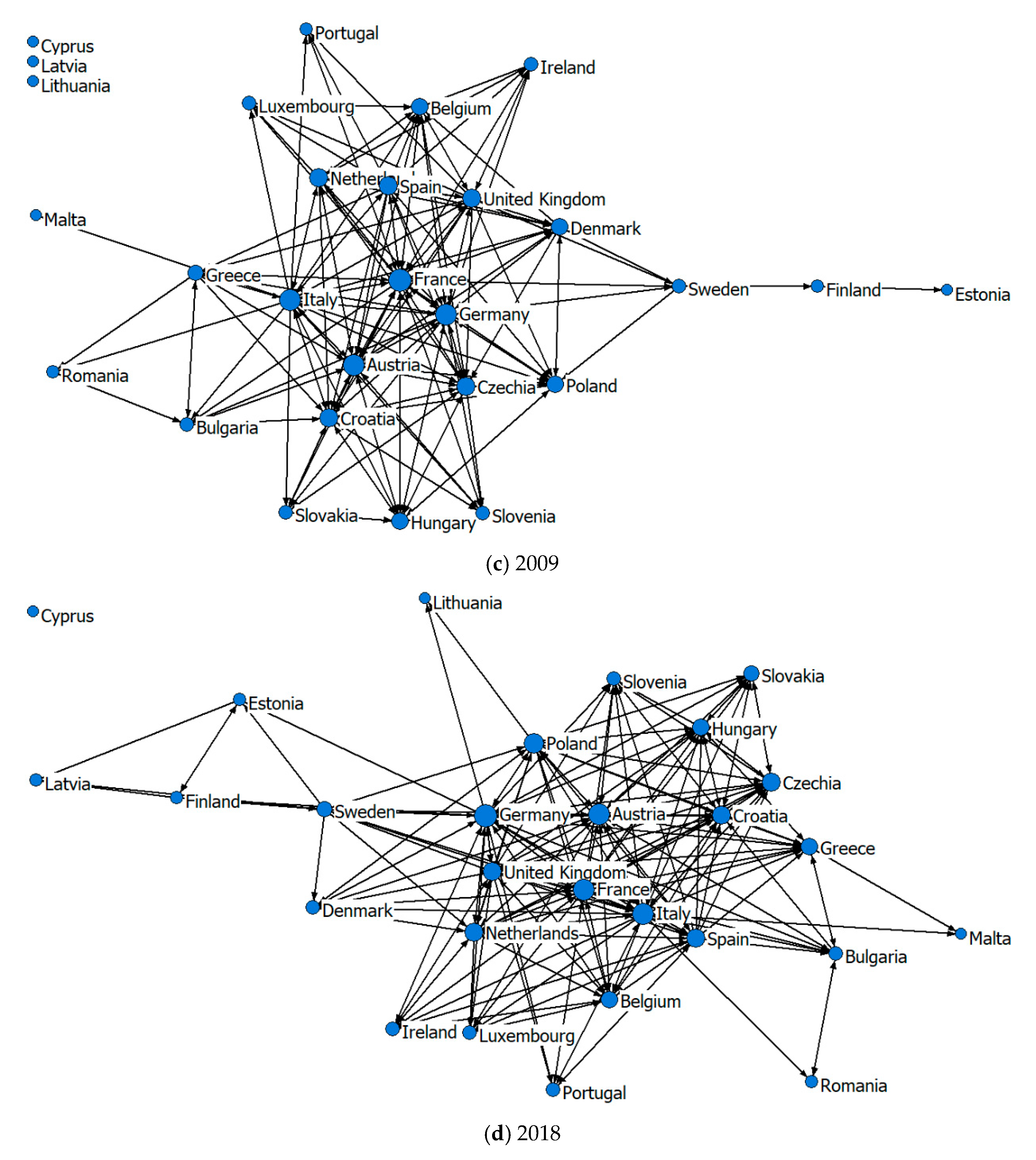
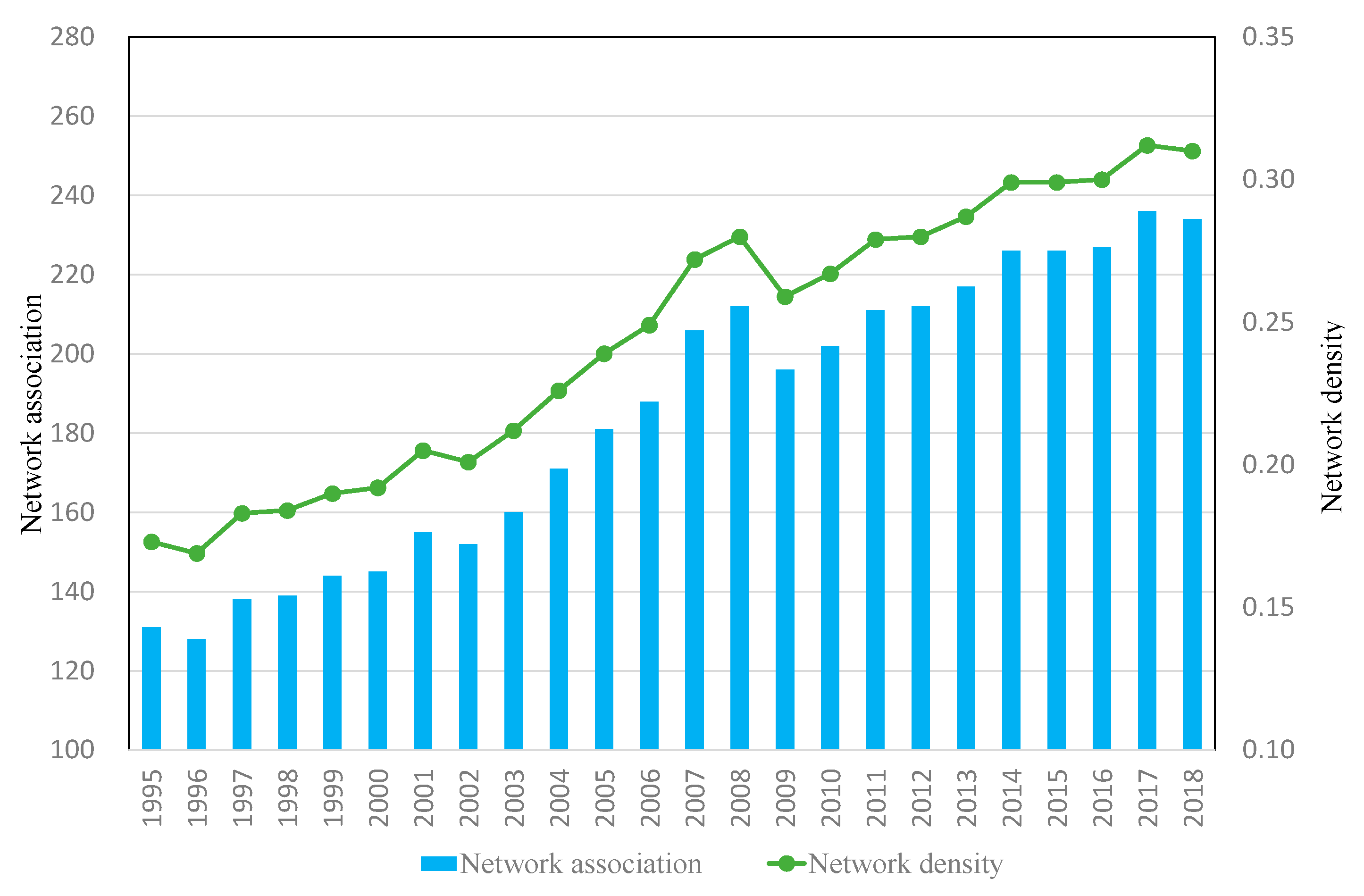

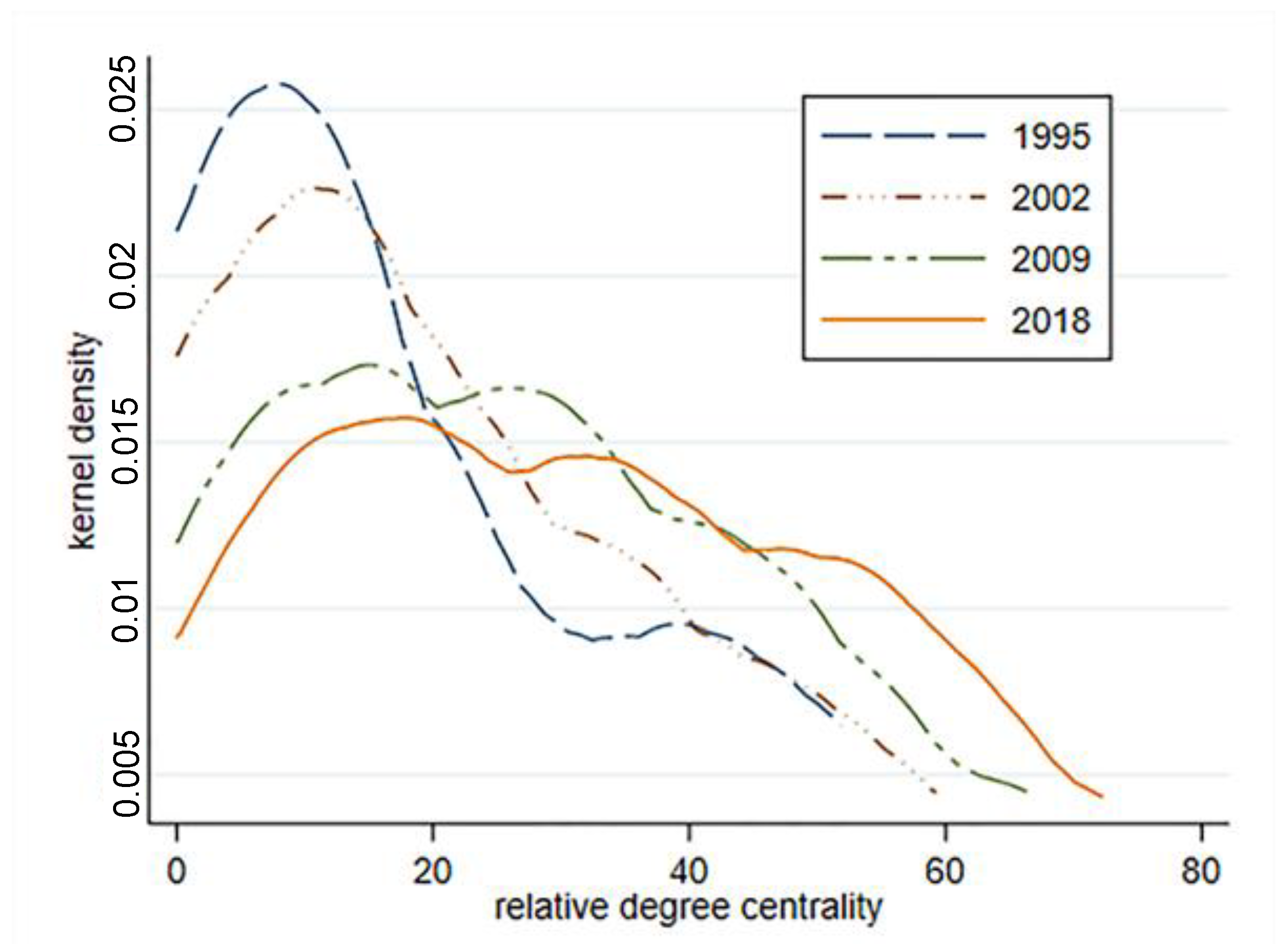
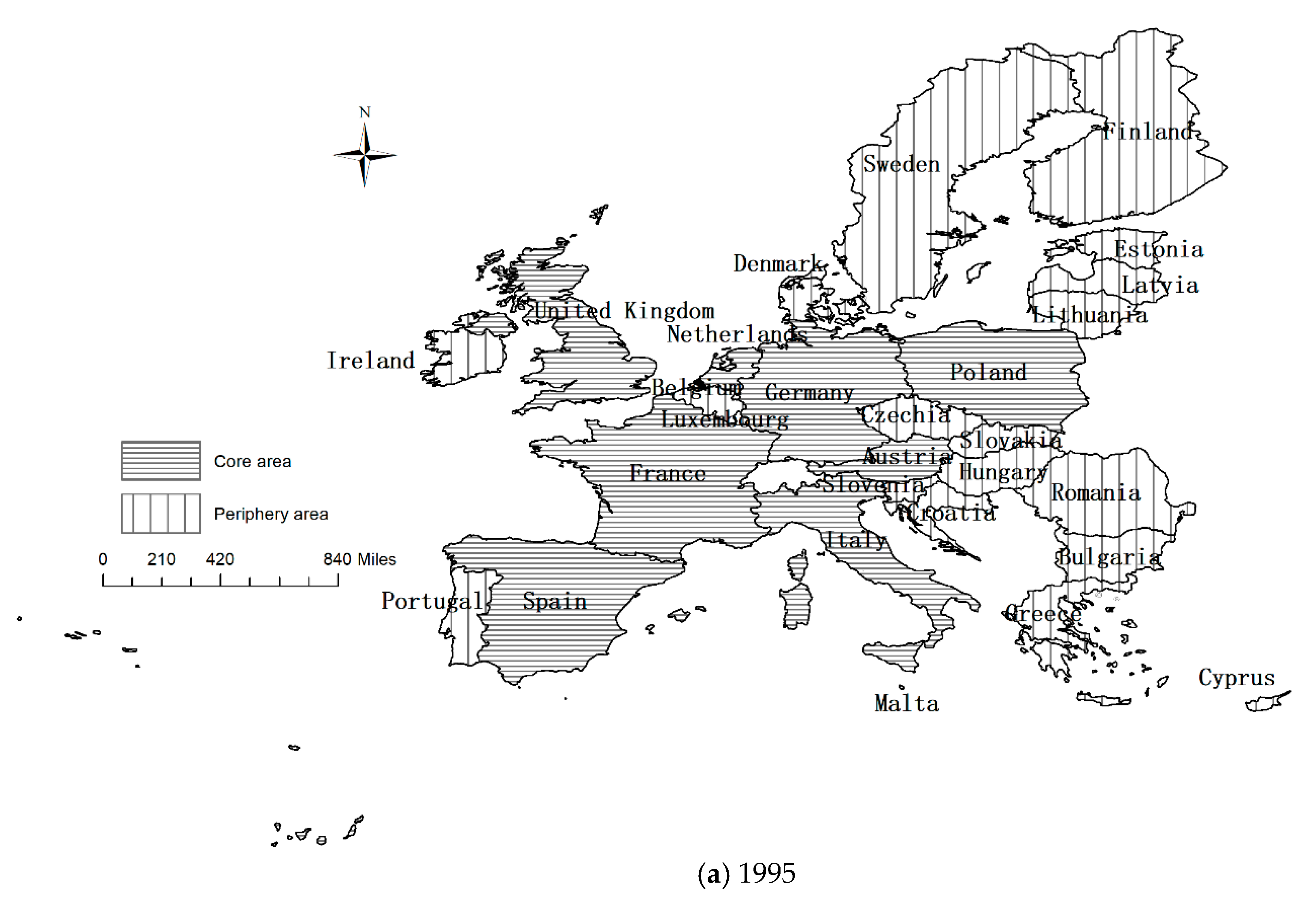
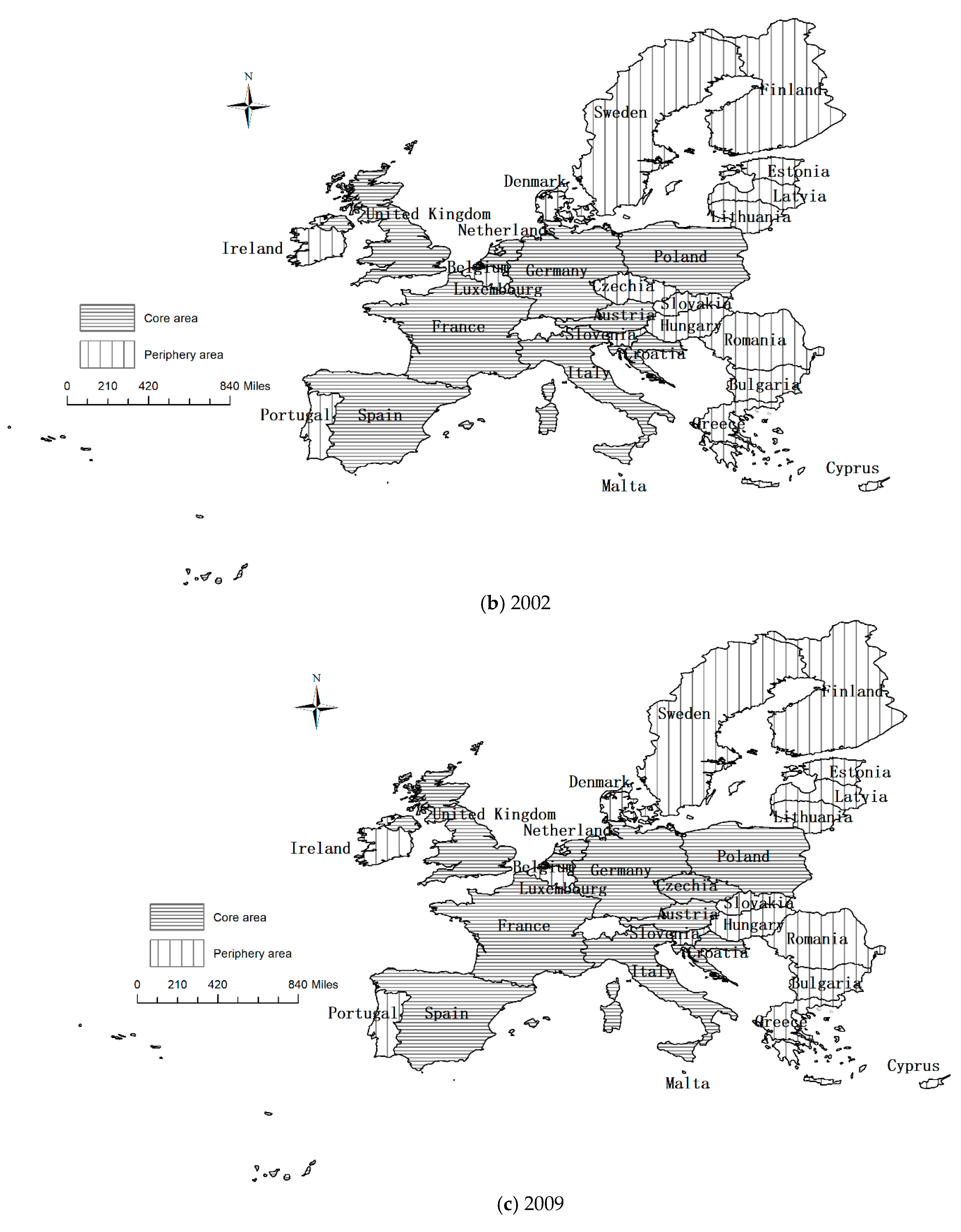
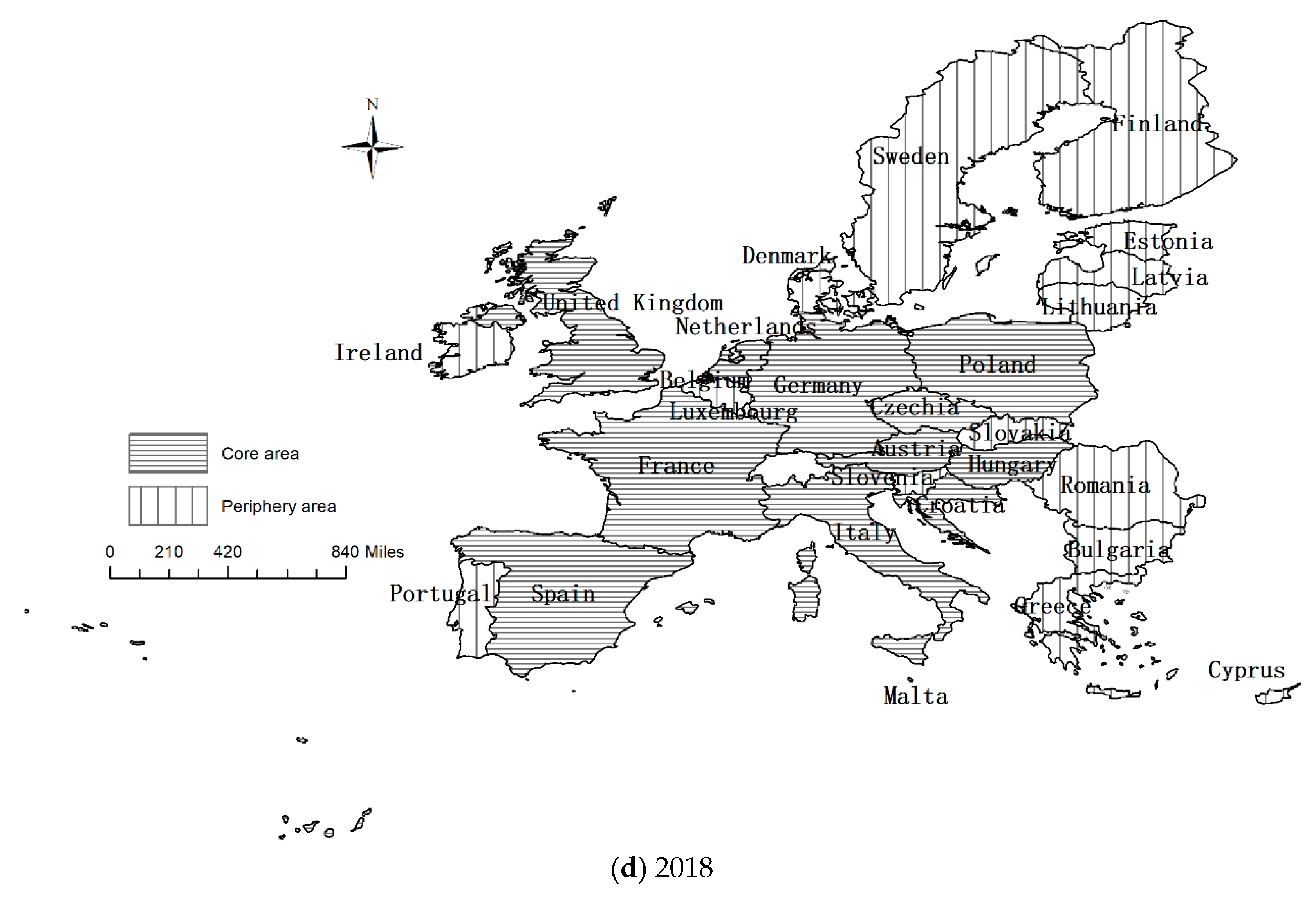
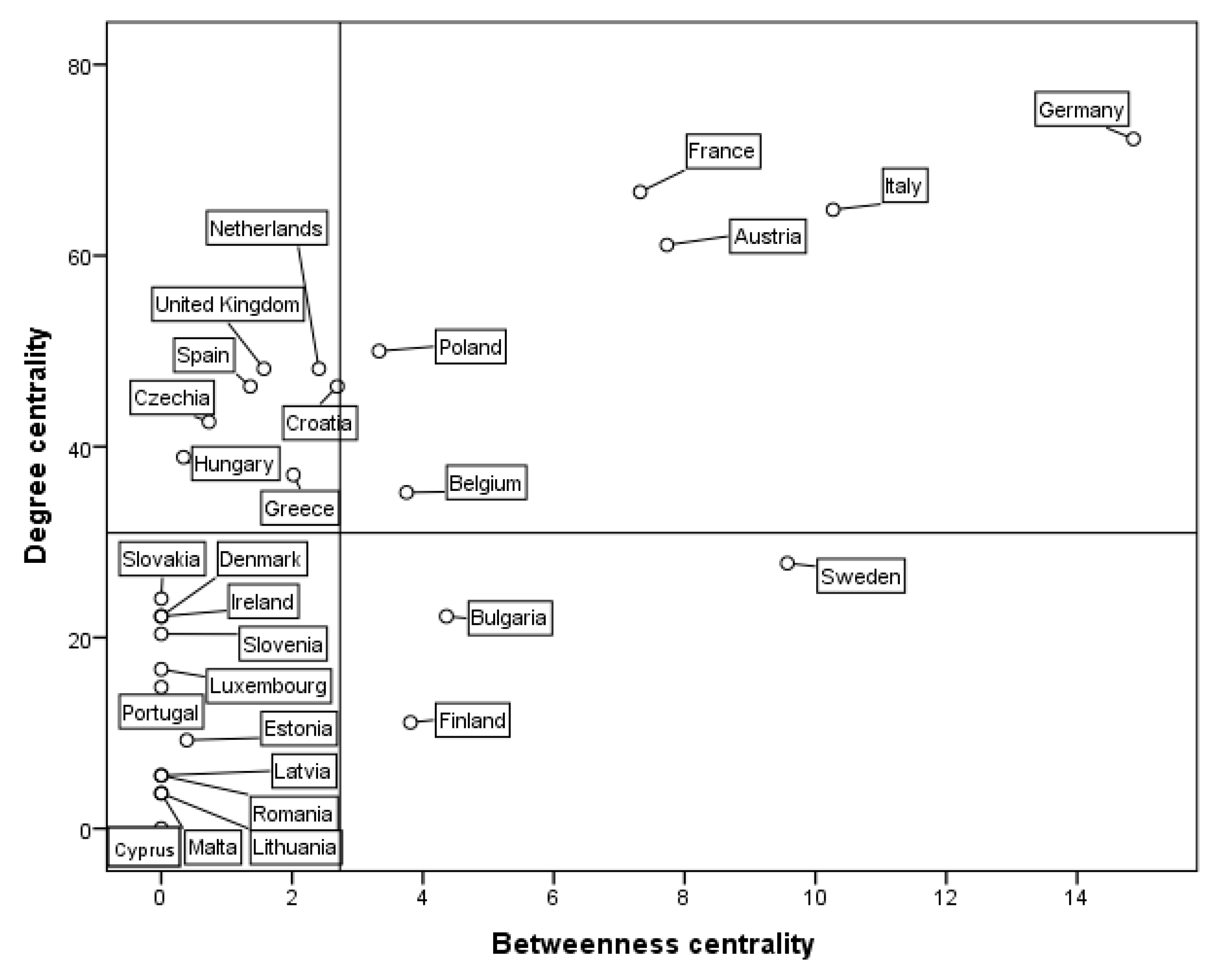
| Nodes (Countries) | 1995 | 2002 | 2009 | 2018 | ||||||||
|---|---|---|---|---|---|---|---|---|---|---|---|---|
| Tourism Economic Connection | Percentage (%) | Rank | Tourism Economic Connection | Percentage (%) | Rank | Tourism Economic Connection | Percentage (%) | Rank | Tourism Economic Connection | Percentage (%) | Rank | |
| United Kingdom | 1084.47 | 23.58 | 1 | 1478.52 | 21.88 | 1 | 2324.60 | 19.06 | 2 | 3803.09 | 16.29 | 2 |
| France | 996.51 | 21.67 | 2 | 1412.76 | 20.91 | 2 | 2361.92 | 19.37 | 1 | 4234.59 | 18.14 | 1 |
| Germany | 443.20 | 9.64 | 3 | 561.61 | 8.31 | 3 | 1200.96 | 9.85 | 4 | 2251.32 | 9.64 | 4 |
| Italy | 330.46 | 7.19 | 4 | 464.54 | 6.87 | 6 | 803.96 | 6.59 | 5 | 1591.39 | 6.82 | 5 |
| Austria | 304.63 | 6.62 | 5 | 539.85 | 7.99 | 4 | 1317.83 | 10.81 | 3 | 2859.41 | 12.25 | 3 |
| Netherlands | 271.44 | 5.90 | 6 | 520.73 | 7.71 | 5 | 629.49 | 5.16 | 7 | 1362.10 | 5.84 | 7 |
| Slovakia | 251.66 | 5.47 | 7 | 279.20 | 4.13 | 8 | 612.37 | 5.02 | 8 | 1127.91 | 4.83 | 8 |
| Spain | 236.27 | 5.14 | 8 | 402.56 | 5.96 | 7 | 690.83 | 5.67 | 6 | 1483.76 | 6.36 | 6 |
| Poland | 120.18 | 2.61 | 9 | 104.59 | 1.55 | 13 | 186.51 | 1.53 | 13 | 445.52 | 1.91 | 13 |
| Hungary | 106.94 | 2.33 | 10 | 129.67 | 1.92 | 11 | 256.12 | 2.10 | 11 | 545.44 | 2.34 | 12 |
| the Czech Republic | 104.94 | 2.28 | 11 | 134.18 | 1.99 | 10 | 310.25 | 2.54 | 10 | 549.67 | 2.35 | 11 |
| Belgium | 99.35 | 2.16 | 12 | 230.30 | 3.41 | 9 | 368.65 | 3.02 | 9 | 632.91 | 2.71 | 9 |
| Denmark | 51.92 | 1.13 | 13 | 71.21 | 1.05 | 14 | 166.82 | 1.37 | 14 | 179.95 | 0.77 | 20 |
| Greece | 35.49 | 0.77 | 14 | 66.04 | 0.98 | 15 | 118.75 | 0.97 | 15 | 252.77 | 1.08 | 14 |
| Croatia | 31.61 | 0.69 | 15 | 111.44 | 1.65 | 12 | 252.31 | 2.07 | 12 | 631.33 | 2.70 | 10 |
| Ireland | 29.85 | 0.65 | 16 | 60.79 | 0.90 | 16 | 103.37 | 0.85 | 16 | 203.25 | 0.87 | 18 |
| Sweden | 25.33 | 0.55 | 17 | 50.24 | 0.74 | 17 | 94.56 | 0.78 | 17 | 205.19 | 0.88 | 17 |
| Finland | 21.12 | 0.46 | 18 | 28.40 | 0.42 | 19 | 85.37 | 0.70 | 18 | 186.12 | 0.80 | 19 |
| Bulgaria | 14.14 | 0.31 | 19 | 23.74 | 0.35 | 20 | 72.48 | 0.59 | 20 | 136.50 | 0.58 | 21 |
| Portugal | 13.99 | 0.30 | 20 | 32.14 | 0.48 | 18 | 76.47 | 0.63 | 19 | 247.59 | 1.06 | 15 |
| Slovenia | 7.39 | 0.16 | 21 | 16.06 | 0.24 | 22 | 70.37 | 0.58 | 21 | 230.72 | 0.99 | 16 |
| Romania | 6.94 | 0.15 | 22 | 5.53 | 0.08 | 24 | 31.36 | 0.26 | 22 | 47.72 | 0.20 | 23 |
| Luxembourg | 5.04 | 0.11 | 23 | 9.44 | 0.14 | 23 | 17.66 | 0.14 | 24 | 23.70 | 0.10 | 24 |
| Estonia | 2.19 | 0.05 | 24 | 16.22 | 0.24 | 21 | 24.26 | 0.20 | 23 | 72.16 | 0.31 | 22 |
| Malta | 1.48 | 0.03 | 25 | 1.58 | 0.02 | 27 | 2.07 | 0.02 | 27 | 5.58 | 0.02 | 27 |
| Lithuania | 1.12 | 0.02 | 26 | 3.16 | 0.05 | 25 | 6.10 | 0.05 | 26 | 17.29 | 0.07 | 25 |
| Cyprus | 0.71 | 0.02 | 27 | 1.22 | 0.02 | 28 | 1.52 | 0.01 | 28 | 3.07 | 0.01 | 28 |
| Latvia | 0.44 | 0.01 | 28 | 2.17 | 0.03 | 26 | 6.35 | 0.05 | 25 | 12.15 | 0.05 | 26 |
| max | 1084.47 | 23.58 | 1478.52 | 21.88 | 2361.92 | 19.37 | 4234.59 | 18.14 | ||||
| min | 0.44 | 0.01 | 1.22 | 0.02 | 1.52 | 0.01 | 3.07 | 0.01 | ||||
| mean | 164.24 | 3.57 | 241.35 | 3.57 | 435.47 | 3.57 | 833.65 | 3.57 | ||||
| total | 4598.81 | 100 | 6757.89 | 100 | 12193.31 | 100 | 23342.20 | 100 | ||||
| Countries | Out Degree | Countries | in Degree | Countries | Degree Centrality | |||||||||
|---|---|---|---|---|---|---|---|---|---|---|---|---|---|---|
| 1995 | 2002 | 2009 | 2018 | 1995 | 2002 | 2009 | 2018 | 1995 | 2002 | 2009 | 2018 | |||
| Germany | 15 | 17 | 19 | 23 | Austria | 15 | 14 | 16 | 17 | Germany | 46.30 | 53.70 | 59.26 | 72.22 |
| Italy | 18 | 16 | 20 | 22 | France | 11 | 14 | 16 | 16 | France | 51.85 | 59.26 | 66.67 | 66.67 |
| France | 17 | 18 | 20 | 20 | Germany | 10 | 12 | 13 | 16 | Italy | 50.00 | 46.30 | 57.41 | 64.81 |
| the UK | 13 | 15 | 16 | 18 | Croatia | 5 | 12 | 14 | 15 | Austria | 48.15 | 48.15 | 55.56 | 61.11 |
| Spain | 10 | 12 | 15 | 17 | Italy | 9 | 9 | 11 | 13 | Poland | 35.19 | 25.93 | 33.33 | 50.00 |
| Austria | 11 | 12 | 14 | 16 | Poland | 11 | 9 | 10 | 13 | the UK | 37.04 | 40.74 | 42.59 | 48.15 |
| Netherlands | 8 | 12 | 12 | 14 | the Czech Republic | 6 | 7 | 12 | 12 | Netherlands | 31.48 | 37.04 | 38.89 | 48.15 |
| Poland | 8 | 5 | 8 | 14 | Netherlands | 9 | 8 | 9 | 12 | Croatia | 12.96 | 29.63 | 40.74 | 46.30 |
| the Czech Republic | 4 | 5 | 10 | 11 | Belgium | 8 | 8 | 11 | 11 | Spain | 27.78 | 33.33 | 38.89 | 46.30 |
| Hungary | 5 | 6 | 9 | 10 | Hungary | 5 | 6 | 8 | 11 | the Czech Republic | 18.52 | 22.22 | 40.74 | 42.59 |
| Croatia | 2 | 4 | 8 | 10 | Greece | 2 | 7 | 7 | 11 | Hungary | 18.52 | 22.22 | 31.48 | 38.89 |
| Greece | 2 | 5 | 6 | 9 | Slovenia | 4 | 5 | 7 | 9 | Greece | 7.41 | 22.22 | 24.07 | 37.04 |
| Sweden | 2 | 3 | 5 | 9 | the UK | 7 | 7 | 7 | 8 | Belgium | 24.07 | 25.93 | 31.48 | 35.19 |
| Belgium | 5 | 6 | 6 | 8 | Luxembourg | 6 | 6 | 7 | 8 | Sweden | 5.56 | 9.26 | 16.67 | 27.78 |
| Ireland | 2 | 3 | 4 | 6 | Slovakia | 3 | 3 | 7 | 8 | Slovakia | 7.41 | 11.11 | 20.37 | 24.07 |
| Denmark | 5 | 4 | 8 | 5 | Spain | 5 | 6 | 6 | 8 | Bulgaria | 1.85 | 5.56 | 18.52 | 22.22 |
| Slovakia | 1 | 3 | 4 | 5 | Denmark | 3 | 4 | 9 | 7 | Denmark | 14.81 | 14.81 | 31.48 | 22.22 |
| Bulgaria | 0 | 1 | 4 | 5 | Bulgaria | 1 | 2 | 6 | 7 | Ireland | 9.26 | 12.96 | 16.67 | 22.22 |
| Portugal | 1 | 2 | 2 | 3 | Ireland | 3 | 4 | 5 | 6 | Slovenia | 9.26 | 11.11 | 16.67 | 20.37 |
| Finland | 1 | 1 | 1 | 3 | Sweden | 1 | 2 | 4 | 6 | Luxembourg | 11.11 | 11.11 | 14.81 | 16.67 |
| Slovenia | 1 | 1 | 2 | 2 | Portugal | 4 | 3 | 4 | 5 | Portugal | 9.26 | 9.26 | 11.11 | 14.81 |
| Estonia | 0 | 1 | 1 | 2 | Finland | 0 | 2 | 2 | 3 | Finland | 1.85 | 5.56 | 5.56 | 11.11 |
| Luxembourg | 0 | 0 | 1 | 1 | Estonia | 1 | 1 | 1 | 3 | Estonia | 1.85 | 3.70 | 3.70 | 9.26 |
| Romania | 0 | 0 | 1 | 1 | Latvia | 0 | 0 | 0 | 3 | Latvia | 0.00 | 0.00 | 0.00 | 5.56 |
| Cyprus | 0 | 0 | 0 | 0 | Romania | 1 | 0 | 3 | 2 | Romania | 1.85 | 0.00 | 7.41 | 5.56 |
| Latvia | 0 | 0 | 0 | 0 | Malta | 1 | 1 | 1 | 2 | Lithuania | 0.00 | 0.00 | 0.00 | 3.70 |
| Lithuania | 0 | 0 | 0 | 0 | Lithuania | 0 | 0 | 0 | 2 | Malta | 1.85 | 1.85 | 1.85 | 3.70 |
| Malta | 0 | 0 | 0 | 0 | Cyprus | 0 | 0 | 0 | 0 | Cyprus | 0.00 | 0.00 | 0.00 | 0.00 |
| mean | 4.68 | 5.43 | 7 | 8.36 | mean | 4.68 | 5.43 | 7 | 8.36 | mean | 17.33 | 20.11 | 25.93 | 30.95 |
| centrality (%) | 51.17% | 48.29% | 49.93% | 56.24% | centrality | 39.64% | 32.92% | 34.57% | 33.2% | centrality (%) | 37.18% | 42.17% | 43.88% | 44.44% |
| Countries | Betweenness Centrality | Countries | Closeness Centrality | ||||||
|---|---|---|---|---|---|---|---|---|---|
| 1995 | 2002 | 2009 | 2018 | 1995 | 2002 | 2009 | 2018 | ||
| Germany | 7.604 | 8.78 | 7.268 | 14.855 | Germany | 15.976 | 19.014 | 23.684 | 47.368 |
| Italy | 12.903 | 9.065 | 8.027 | 10.271 | Italy | 16.265 | 18.621 | 23.478 | 46.552 |
| Sweden | 0 | 5.413 | 5.983 | 9.568 | France | 16.168 | 19.149 | 23.894 | 45 |
| Austria | 12.831 | 7.213 | 9.188 | 7.734 | the UK | 15.789 | 18.493 | 23.077 | 43.548 |
| France | 8.984 | 15.045 | 13.449 | 7.316 | Austria | 15.976 | 18.493 | 22.689 | 43.548 |
| Bulgaria | 0 | 0 | 3.678 | 4.358 | Spain | 15.517 | 18.121 | 22.5 | 42.188 |
| Finland | 0 | 2.849 | 3.134 | 3.806 | Poland | 15.698 | 17.881 | 22.131 | 42.188 |
| Belgium | 0.332 | 0.347 | 3.742 | 3.751 | Netherlands | 15.517 | 18.121 | 21.951 | 41.538 |
| Poland | 1.93 | 0.14 | 0.491 | 3.327 | Croatia | 15.169 | 18.121 | 22.314 | 40.909 |
| Croatia | 0.103 | 4.009 | 3.619 | 2.689 | the Czech Republic | 15.169 | 17.647 | 22.314 | 39.706 |
| Netherlands | 0.819 | 1.426 | 1.551 | 2.406 | Belgium | 15.429 | 17.763 | 21.774 | 39.13 |
| Greece | 0 | 3.986 | 1.424 | 2.023 | Greece | 14.835 | 17.647 | 21.429 | 39.13 |
| the UK | 2.473 | 1.936 | 2.373 | 1.569 | Hungary | 15.254 | 17.532 | 21.429 | 39.13 |
| Spain | 3.245 | 1.347 | 1.195 | 1.362 | Sweden | 14.286 | 17.197 | 21.094 | 39.13 |
| the Czech Republic | 0 | 0.018 | 1.144 | 0.732 | Denmark | 14.917 | 17.089 | 22.131 | 37.5 |
| Estonia | 0 | 0 | 0 | 0.387 | Slovenia | 14.917 | 13.308 | 21.094 | 37.5 |
| Hungary | 0.199 | 1.246 | 0.566 | 0.34 | Luxembourg | 15.169 | 17.419 | 21.094 | 36.986 |
| Denmark | 0 | 0 | 1.117 | 0 | Slovakia | 14.516 | 16.77 | 21.094 | 36.986 |
| Cyprus | 0 | 0 | 0 | 0 | Bulgaria | 14.439 | 16.265 | 21.094 | 36.986 |
| Ireland | 0 | 0 | 0 | 0 | Ireland | 14.516 | 16.981 | 20.611 | 36.486 |
| Latvian | 0 | 0 | 0 | 0 | Portugal | 14.835 | 16.77 | 20.611 | 35.526 |
| Latvian | 0 | 0 | 0 | 0 | Finland | 3.704 | 15.254 | 18.121 | 34.615 |
| Luxembourg | 0 | 0 | 0 | 0 | Estonia | 3.704 | 13.568 | 15.698 | 34.615 |
| Malta | 0 | 0 | 0 | 0 | Latvian | — | — | — | 33.333 |
| Portugal | 0 | 0 | 0 | 0 | Romania | 14.439 | — | 19.853 | 32.927 |
| Romania | 0 | 0 | 0 | 0 | Malta | 14.439 | 16.168 | 19.565 | 32.927 |
| Slovakia | 0 | 0 | 0 | 0 | Latvian | — | — | — | 29.348 |
| Slovenia | 0 | 0 | 0 | 0 | Cyprus | — | — | — | — |
| mean | 1.84 | 2.24 | 2.43 | 2.73 | |||||
| centrality (%) | 11.48 | 13.28 | 11.43 | 12.57 | |||||
| State | EU Member Country | Euro Area Member | Schengen Area Member | |
|---|---|---|---|---|
| Northern Europe | Denmark | 1973 | 2001 | |
| Finland | 1995 | 2002 | 2001 | |
| Ireland | 1973 | 2002 | ||
| Sweden | 1995 | 2001 | ||
| Norway | 2001 | |||
| Iceland | 2001 | |||
| United Kingdom | 1973 | |||
| Western Europe | Austria | 1995 | 2002 | 1997 |
| Belgium | 1958 | 2002 | 1995 | |
| France | 1958 | 2002 | 1995 | |
| Germany | 1958 | 2002 | 1995 | |
| Switzerland | 2008 | |||
| Liechtenstein | 2011 | |||
| Luxembourg | 1958 | 2002 | 1995 | |
| Netherlands | 1958 | 2002 | 1995 | |
| Central/Eastern Europe | Bulgaria | 2007 | ||
| Czech Republic | 2004 | 2007 | ||
| Estonia | 2004 | 2011 | 2007 | |
| Hungary | 2004 | 2007 | ||
| Latvia | 2004 | 2014 | 2007 | |
| Lithuania | 2004 | 2015 | 2007 | |
| Poland | 2004 | 2007 | ||
| Romania | 2007 | |||
| Slovakia | 2004 | 2009 | 2007 | |
| Southern/Medit. Europe | Croatia | 2013 | ||
| Cyprus | 2004 | 2008 | ||
| Greece | 1981 | 2002 | 2000 | |
| Italy | 1958 | 2002 | 1997 | |
| Malta | 2004 | 2008 | 2007 | |
| Portugal | 1986 | 2002 | 1995 | |
| Slovenia | 2004 | 2007 | 2007 | |
| Spain | 1986 | 2002 | 1995 |
| Variables | Tourism Industry Specialization | Coefficient of Variation of Tourism Economic Development Level |
|---|---|---|
| (1) | (2) | |
| constant | 3.9863 ** | 0.8538 |
| Network Density | 1.6419 * | 0.4092 |
| Connectedness | −1.4153 | −0.6490 ** |
| Graph Hierarchy | 0.0972 | 0.0166 |
| Graph Efficiency | 2.2175 | 1.2423 ** |
| R2 | 0.4012 | 0.9316 |
| Variables | Tourism Industry Specialization |
|---|---|
| Constant | 0.7400 *** |
| Degree centrality | 0.3129 *** |
| Betweenness centrality | 0.0331 *** |
| Closeness centrality | −0.0384 * |
| R2 | 0.3068 |
| Number of observations | 672 |
Publisher’s Note: MDPI stays neutral with regard to jurisdictional claims in published maps and institutional affiliations. |
© 2021 by the authors. Licensee MDPI, Basel, Switzerland. This article is an open access article distributed under the terms and conditions of the Creative Commons Attribution (CC BY) license (http://creativecommons.org/licenses/by/4.0/).
Share and Cite
Xie, W.; Li, H.; Yin, Y. Research on the Spatial Structure of the European Union’s Tourism Economy and Its Effects. Int. J. Environ. Res. Public Health 2021, 18, 1389. https://doi.org/10.3390/ijerph18041389
Xie W, Li H, Yin Y. Research on the Spatial Structure of the European Union’s Tourism Economy and Its Effects. International Journal of Environmental Research and Public Health. 2021; 18(4):1389. https://doi.org/10.3390/ijerph18041389
Chicago/Turabian StyleXie, Wujie, Haijian Li, and Yufang Yin. 2021. "Research on the Spatial Structure of the European Union’s Tourism Economy and Its Effects" International Journal of Environmental Research and Public Health 18, no. 4: 1389. https://doi.org/10.3390/ijerph18041389





